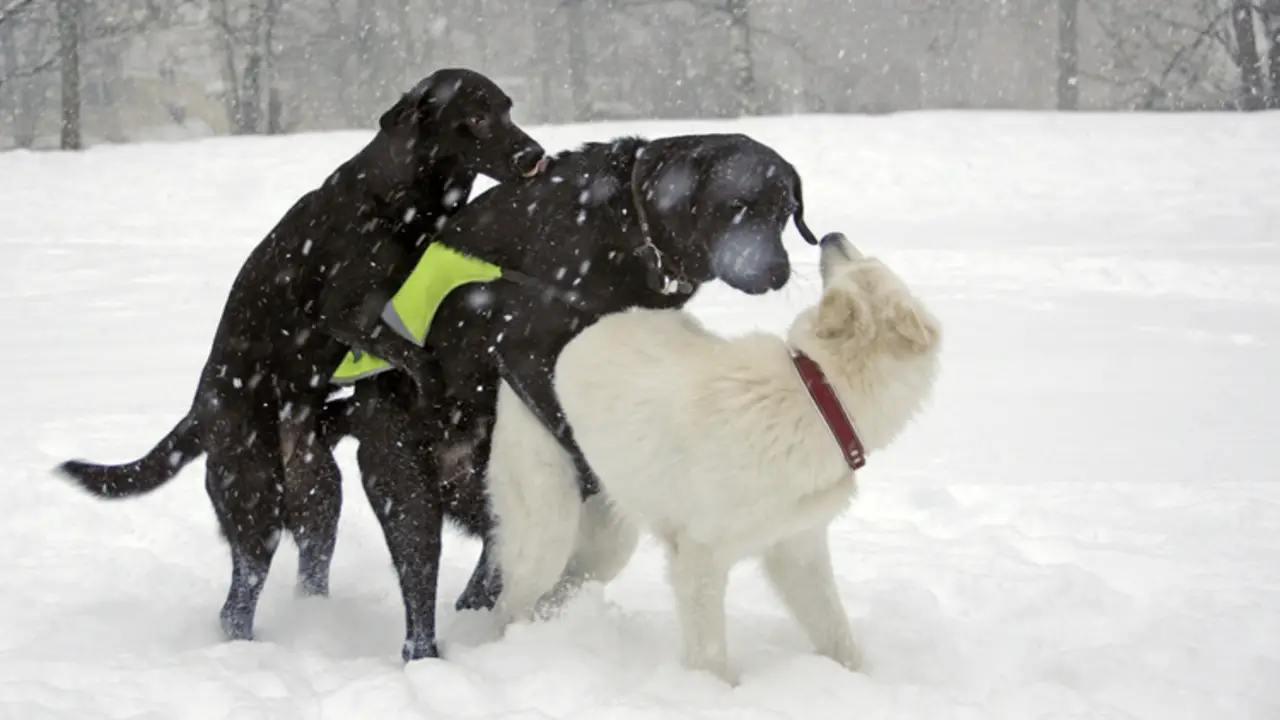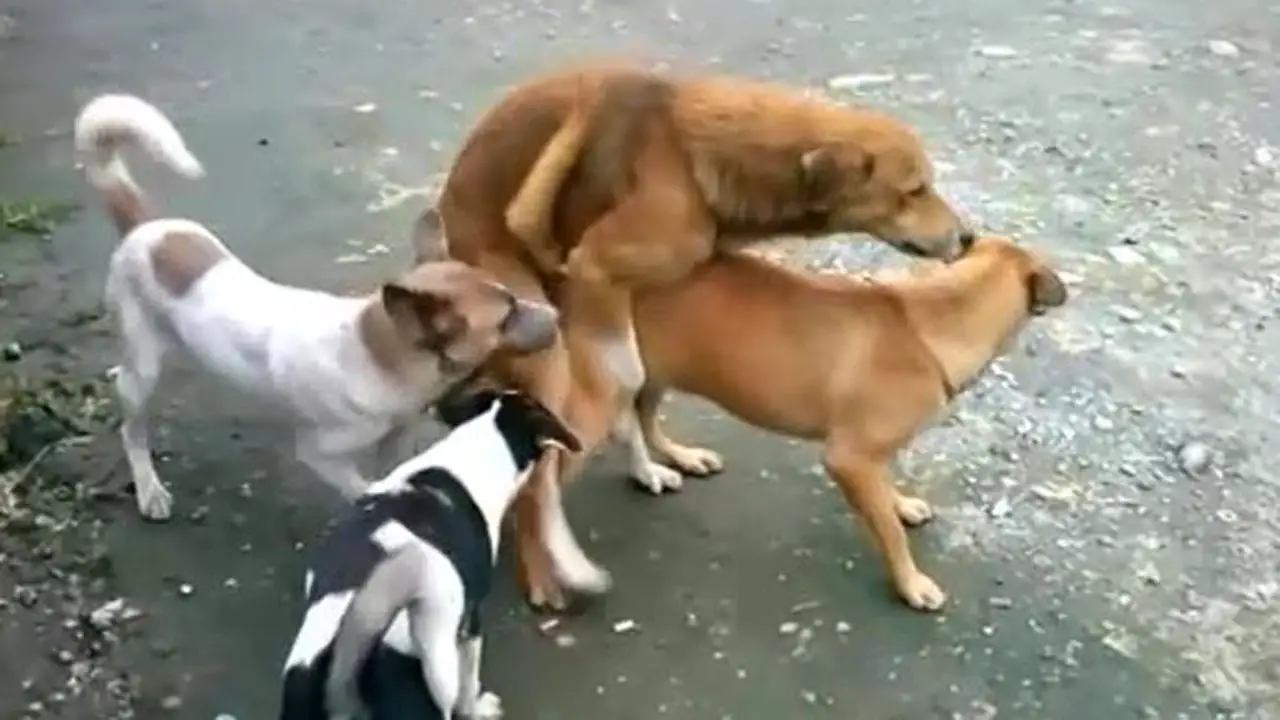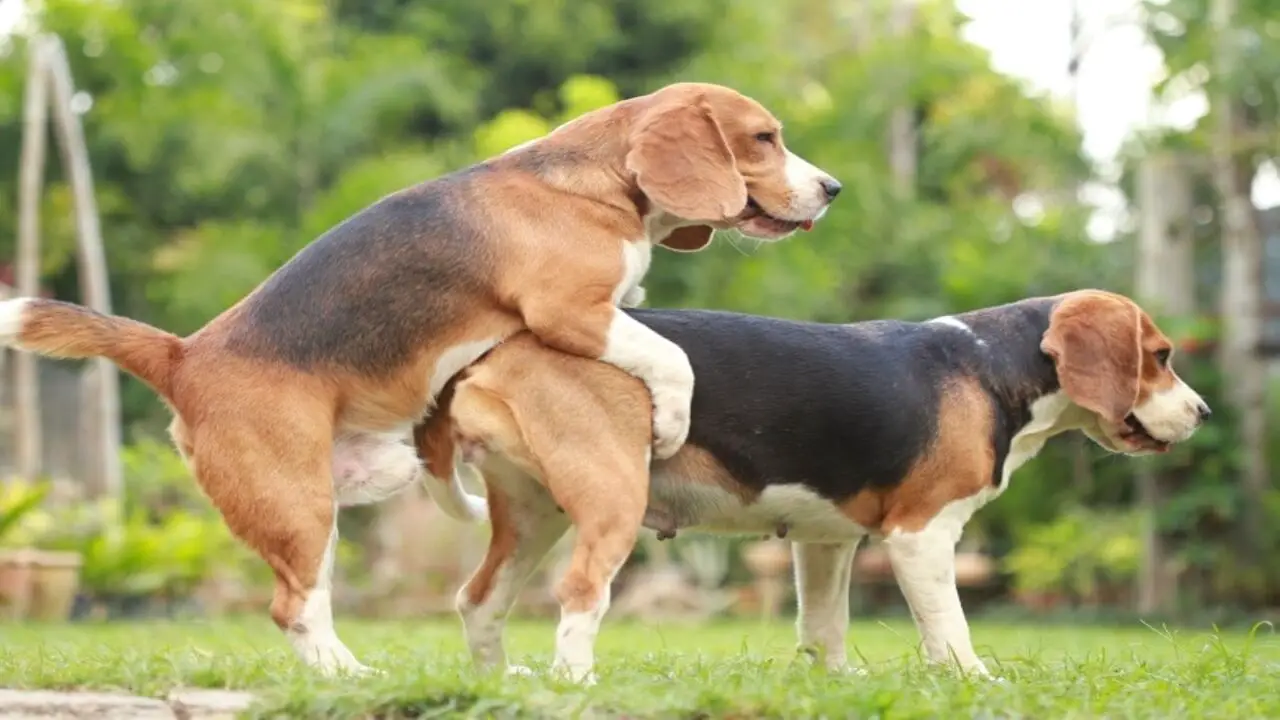As pet owners, we want to ensure the health and well-being of our furry companions. However, specific questions may seem awkward or uncomfortable to ask. One of these is the possibility of male dogs engaging in sexual behavior with each other.
It is a common misconception that dogs only mate with the opposite sex, but same-sex behavior is not uncommon in the animal kingdom. Therefore, it is important for pet owners to have a clear understanding of whether a male dog can penetrate another male dog or not.
We will delve into can a male dog penetrate another male dog, exploring the biology and behavior of dogs in relation to same-sex interactions. We will discuss why male dogs may engage in such behavior and the potential risks involved.

What Causes Male Dogs To Mate?

Male dogs mate for various reasons, primarily driven by their natural instincts and hormonal changes. One of the main factors that trigger male dogs to mate is the presence of a receptive female in heat. The pheromones released by the female dog signal to the male that she is ready to mate. Prompting him to engage in mating behaviors.
Male dogs may also be motivated to mate by their territorial instincts and the desire to establish dominance over other males. It’s important to note that male dogs can exhibit mounting behavior towards other males. It is typically a display of dominance rather than sexual intent.
Can A Male Dog Penetrate Another Male Dog Details Explain

Discussion on can a male dog penetrate another male dog. Whether a male dog can penetrate another male dog is a question that often arises in discussions about animal behavior. It is important to note that dogs engage in various forms of sexual behavior, including mounting and humping, as part of their natural, instinctual behaviors. However, it is not common for male dogs to physically penetrate each other during these interactions.
The act of penetration typically occurs between male and female dogs during mating. Male dogs may exhibit mounting behavior towards other males as a display of dominance or social hierarchy rather than for reproductive purposes. It is essential to understand the complexities of canine behavior and consult a veterinarian or animal behaviorist for any concerns regarding your pet’s health or well-being.
Biological Perspective
From a biological perspective, a male dog can’t penetrate another male dog. Like most mammals, dogs have reproductive systems specifically designed for heterosexual mating. Male dogs have a penis anatomically suited for mating with female dogs. And they typically engage in sexual behaviors exclusively with females.
While same-sex mounting or humping can occur among male dogs as a display of dominance or social behavior. It does not involve penetration or actual reproduction. It’s important to note that the concept of homosexuality in animals is complex and can vary across different species. Still, in the case of male dogs, their reproductive anatomy limits their ability to engage in sexual penetration with other males.
Male Dog Anatomy
Understanding male dog anatomy is important when it comes to questions about penetration. Male dogs have a reproductive system that includes a penis, testicles, and a sheath. During sexual activity, the male dog’s penis can become erect and extend from the sheath. However, it is important to note that penetration between two male dogs typically does not occur naturally or for reproductive purposes.
Male dogs engage in mounting behavior as a dominance display or as part of play behavior rather than for sexual reproduction. If you have concerns or questions about your male dog’s behavior. It is always best to consult a veterinarian who can provide accurate information and guidance.
Sexual Behavior Of Male Dogs
The sexual behavior of male dogs can vary depending on the individual and the circumstances. It is not uncommon for male dogs to engage in mounting behavior, which can involve one dog attempting to mount another, regardless of gender. This behavior is often a display of dominance or territoriality rather than a sexual act.
However, it is important to note that dogs engaging in this behavior are not necessarily exhibiting homosexual tendencies. Mounting behavior can occur between dogs of the same sex or opposite sex and does not necessarily indicate a sexual interest. If you have concerns about your dog’s behavior. It is always best to consult a veterinarian or animal behaviorist for guidance.
Reasons For Same-Sex Behavior In Dogs

Same-sex behavior in dogs can occur for a variety of reasons. One possible explanation is social bonding and dominance. Dogs, like many other animals, establish social hierarchies within their packs. Same-sex mounting and humping can allow dogs to assert dominance or establish their place within the pack. Another reason for same-sex behavior could be sexual frustration or a lack of opposite-sex partners.
If a male dog cannot mate with a female, he may turn to same-sex mounting as an outlet for his sexual energy. It’s important to note that same-sex dog behavior is generally considered normal and does not necessarily indicate any underlying issues. However, if the behavior becomes excessive or aggressive. It may be worth consulting a veterinarian or animal behaviorist for further guidance.
Homosexuality In Animals
Homosexuality in animals is a well-documented phenomenon observed in many species, including dogs. While it is true that male dogs may engage in mounting or humping behavior towards other males, it is important to note that this behavior does not necessarily indicate sexual attraction or penetration.
In many cases, mounting behavior can display dominance or social interaction rather than a sexual act. It is also worth mentioning that same-sex behavior in animals is not limited to males and can be observed among female animals. Overall, the existence of homosexuality in animals serves as a reminder that diverse sexual behaviors and orientations can be found throughout the natural world.
Prevalence Of Same-Sex Behavior In Animals
Same-sex behavior is actually quite common in the animal kingdom. Many animals, including dogs, engage in same-sex mating or sexual behaviors. Same-sex behavior can serve various purposes in animals, such as establishing dominance, forming social bonds, or even practicing for future heterosexual encounters.
It is important to note that same-sex behavior does not necessarily indicate a specific sexual orientation or preference in animals, as their motivations and behaviors are driven by instinct and biology rather than personal identity. The prevalence of same-sex behavior in animals highlights the diversity of sexual behaviors and relationships in the natural world.
Possible Evolutionary Explanations

Possible evolutionary explanations can help shed light on the behavior of male dogs attempting to penetrate other male dogs. While this behavior may seem puzzling or even alarming, it is important to understand that animals, including dogs, have complex mating behaviors influenced by various factors.
One possible explanation is that this behavior results from dominance and social hierarchy within a pack. By attempting to mount another male dog, the initiating dog may assert dominance and establish its position within the group.
Another possible explanation is that this behavior is a form of play or social bonding between male dogs. Dogs often engage in mounting behaviors during play sessions, and this can be a way for them to establish social connections and strengthen their bonds with each other.
It’s important to note that this behavior does not necessarily indicate sexual orientation or preferences in dogs, as their motivations are driven by instinctual and social factors rather than sexual attraction.
Factors That Affect Sexual Behavior In Dogs
A variety of factors can influence sexual behavior in dogs. One important factor is the dog’s age and hormonal status. Intact male dogs, also known as “unneutered” or “intact” males, are more likely to engage in sexual behaviors such as mounting and attempting to penetrate other dogs. Neutering or spaying a dog can help reduce these behaviors.
Another factor that can affect sexual behavior in dogs is socialization and training. Dogs not properly socialized may exhibit more dominant or sexually motivated behaviors toward other dogs. Training and socialization can help teach dogs appropriate behaviors and reduce unwanted sexual behaviors.
Additionally, the presence of a receptive female dog, known as being “in heat,” can influence the sexual behavior of male dogs. When a female dog is in heat, she emits pheromones that can attract males and trigger mating behaviors.
It’s important for dog owners to understand that sexual behaviors between dogs should always be monitored and managed appropriately. If you have concerns about your dog’s sexual behavior, it’s best to consult with a veterinarian or professional dog trainer for guidance.
Cases Of Male Dog Penetration
Male dog penetration is a rare occurrence and typically only happens in specific cases. It can happen during aggressive or dominant behavior, such as during a fight or when one male dog is attempting to establish dominance over another. Additionally, male dogs may engage in mounting behavior as a display of dominance or playfulness, but this does not necessarily involve penetration.
It’s important to note that male dog penetration is not typical or natural and should not be encouraged or tolerated. If you have concerns about the behavior of your male dog, it is recommended to consult with a veterinarian or professional dog trainer for guidance and assistance.
Risks And Consequences Of Same-Sex Mating For Dogs

Same-sex mating in dogs can pose certain risks and consequences. One of the main concerns is the potential for injuries during mating attempts, as male dogs may engage in aggressive behavior toward each other. This can lead to bites, scratches, and other injuries that may require veterinary attention. Additionally, same-sex mating does not result in reproduction, so there is no chance of producing offspring.
It is important to note that same-sex mating can also lead to social and behavioral issues, as it may disrupt the dynamics within a group of dogs or create tension between individual dogs. While same-sex mating is possible among male dogs, it is not recommended due to the associated risks and consequences.
Conclusion
It is essential to debunk the myth that male dogs can physically penetrate one another. While mounting behavior may occur between male dogs, it displays dominance and social hierarchy rather than a sexual act. Dogs show dominance through various behaviors, including mounting, but it does not indicate same-sex attraction or penetration.
Understanding and educating others about dog behavior is crucial to dispel misconceptions and promote responsible pet ownership. Providing furry friends with a safe, loving, and inclusive environment is more important than speculating on their sexual behaviors. We hope now you understand can a male dog penetrate another male dog.
Frequently Asked Questions
Can Dogs Get Stuck Together If Males Are Neutered?
Yes, dogs can get stuck together if they are neutered. This is because when males are neutered, their testicles shrink. As a result, the scrotal skin becomes tight and the dog may become stuck together while performing an activity such as playing.
What Are The Reasons Behind Male Dogs Exhibiting This Behavior?
Male dogs may mount other males as a display of dominance or during play. Hormonal changes and sexual arousal can also contribute to this behavior. Lack of socialization or improper training may be another factor. Redirecting the behavior through positive reinforcement training and ensuring proper socialization is important.
Can This Behavior Lead To Any Health Or Behavioral Issues In Male Dogs?
Male dogs attempting to mount each other is natural, but it doesn’t involve penetration. It’s more about dominance and social hierarchy. Repeated attempts can indicate underlying behavioral issues that may require professional intervention. Physically, aggressive behavior during mounting can lead to injury or infection, so monitoring and intervention are important.
Are There Any Ways To Prevent Or Discourage This Behavior In Male Dogs?
Preventing or discouraging male dogs from penetrating each other is possible. Neutering your dog can reduce the likelihood of this behavior while providing sufficient physical and mental stimulation helps prevent it. Training your dog with basic obedience commands like “leave it” or “stop” also discourages such behavior. Consistency and patience are key in addressing this issue.
Is It Possible For Male Dogs To Engage In Sexual Activity With Other Male Dogs?
Male dogs can engage in sexual activity with other male dogs, especially among unneutered ones. This behavior is often a display of dominance or territoriality. While it does not result in reproduction, it can still transmit diseases. Neutering may reduce the likelihood, but it’s not a guarantee.

Aquarium passion is all about connecting with the aquatic life and providing education to the public on the importance of these creatures. We showcase a wide variety of marine life through our exhibits as well as working with schools to provide unique learning opportunities for students of all ages.







